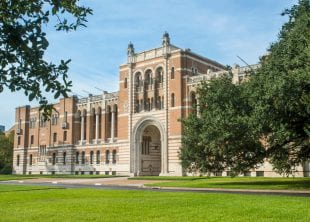The transformation of the Academic Quadrangle on the campus of Rice University is entering the initial phases of active construction. The iconic space, flanked by Lovett Hall and Fondren Library, will preserve the university’s legacy and create new areas that will build community and deepen connections to this important part of campus. Construction fencing has been erected around the entire perimeter for safety. Non-permitted work, including sidewalk, hedge, and grass removal, has commenced. And this week, the methodical work of raising and relocating the Founder’s Memorial statue was completed.
The descendants of William Marsh Rice and members of the Rice University Board of Trustees and senior leaders have worked together in a deliberative and careful manner to respect and maintain the history and extraordinary philanthropy of the university’s founder. In accordance with the family’s wishes the remains of William Marsh Rice have been transferred to the Rice family plot in Glenwood Cemetary, where he will be interred alongside his brother Frederick Allyn Rice and his nephews Benjamin Botts Rice and William Marsh (Will) Rice II, all Rice University trustees and benefactors.
The next stage in the construction process will include attaching the Founder’s Memorial statue to the plinth and securing the plinth in its final location within the Academic Quadrangle. From there, landscape and design work will begin, including the creation of gathering spaces and the planting of ground covering, trees, and shrubbery. Landscape architecture firm Nelson Byrd Woltz is partnering with Rice on the project, which is expected to be completed in late April of next year, in time for the Spring 2024 Commencement activities.
We look forward to maintaining dialogue with the family of William Marsh Rice as we endeavor to honor and acknowledge the university’s rich, ever-evolving history and promising future, together.

